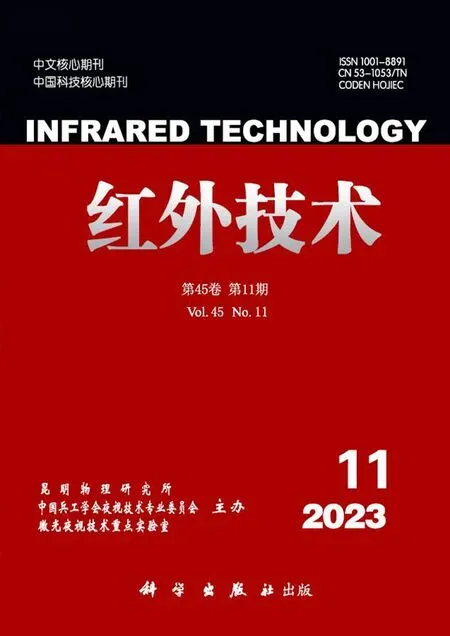高效叠层OLED白光器件进展
常 诚,钱福丽,芶国汝,唐 锐,王体炉,高思博,张韦晨曦,何阳阳,李 理,杨启鸣,张 杰,刘颖琪,段 瑜,杨文运,王光华
高效叠层OLED白光器件进展
常 诚,钱福丽,芶国汝,唐 锐,王体炉,高思博,张韦晨曦,何阳阳,李 理,杨启鸣,张 杰,刘颖琪,段 瑜,杨文运,王光华
(云南北方奥雷德光电科技股份有限公司,云南 昆明 650223)
叠层有机发光二极管(Organic Light-Emitting Diode,OLED)白光器件具备低功耗、高亮度、高色域等性能优势。然而,由于效率、寿命及驱动电压等性能仍有较大改进空间,叠层结构的材料及电学结构仍需进一步优化。本文重点介绍叠层OLED白光器件的最新研究进展,总结了三类电荷产生层(Charge Generation Layer,CGL)在工程化应用中存在的问题以及其非破坏性检测方法;综述高效叠层OLED白光器件的“全磷光体系”、“并行通道激子收集”及“混合磷光热活性型延迟荧光(Thermally Activated Delayed Fluorescence,TADF)体系”最新研究成果,对器件寿命问题进行总结,探讨分析“分级掺杂”、“四色混合TADF体系”等从结构方面提出优化方案,并针对不同发光材料体系中的CGL材料及结构综述叠层OLED白光器件实现较低工作电压的技术方法,最后对叠层OLED白光器件的材料和结构提出改进建议。
叠层白光有机发光二极管;电荷产生层;有机发光单元;功能层结构;有机发光材料
0 引言
由于高效率、低功耗、宽视角、快速响应、薄厚度等[1-3]优点,OLED受到市场及研究者的广泛关注[4-6]。为进一步提升发光效率及器件寿命,以应对OLED的商业化需求,研究者提出了叠层器件架构的设计[7]。
本文将着重介绍近年来高效率叠层OLED白光器件的研究进度;总结近年来实现高效率叠层OLED白光器件的最新策略;介绍叠层OLED白光器件中最具代表性的功能层——电荷产生层的研究进展以及重点介绍4种不同发光材料的叠层发光结构,即叠层荧光、叠层磷光、叠层TADF和叠层混合发光材料白光OLED的研究进展;最后,对叠层白光OLED的发展进行展望。
1 高效叠层OLED白光器件材料及结构
1.1 OLED简述
1950年,法国南锡大学的Bornanose等人通过使用高压交流电观察到吖啶橙(Acridine orange)和奎纳克林(Quinacrine)的电致发光现象[8]。随后的几十年间有机电致发光现象被深入探索并实现工程化应用(图1)[9-10]。目前,OLED应用于手机、VR等高分辨率显示市场[11-16]。
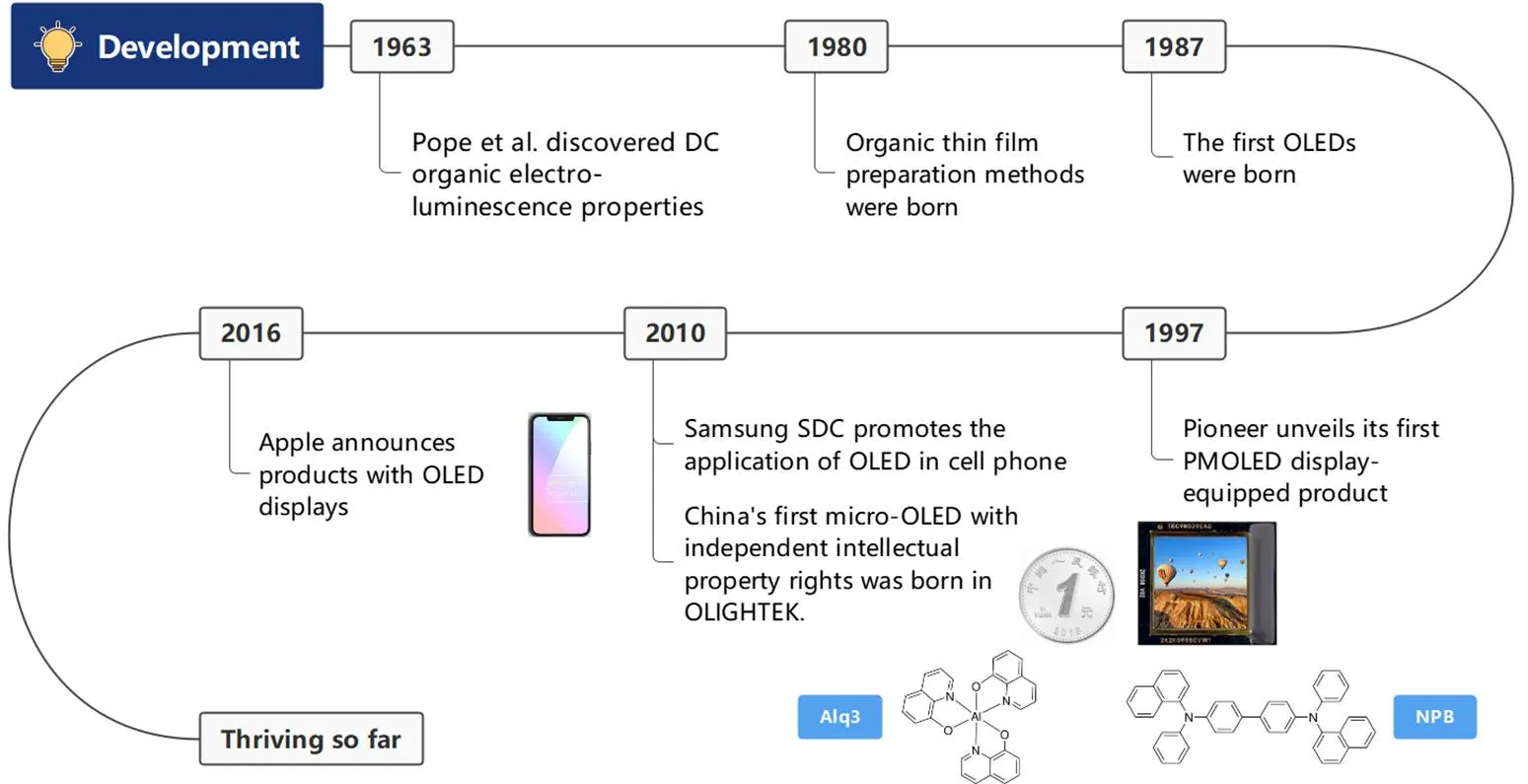
图1 OLED器件发展时间线
OLED器件结构可简单视为由阳极(Anode)、阴极(Cathode)、空穴层(Hole Layer,HL)、电子层(Electron Layer,EL)和有机发光层(Emitting Layer,EML)组成。如图2所示,所述电致发光就是在外部电场的作用下使得EML中的有机物分子处于不稳定态(激发态),其为回到稳定的电子组态(基态)需要将能量释放,从而形成光子或热的辐射[17-19]。
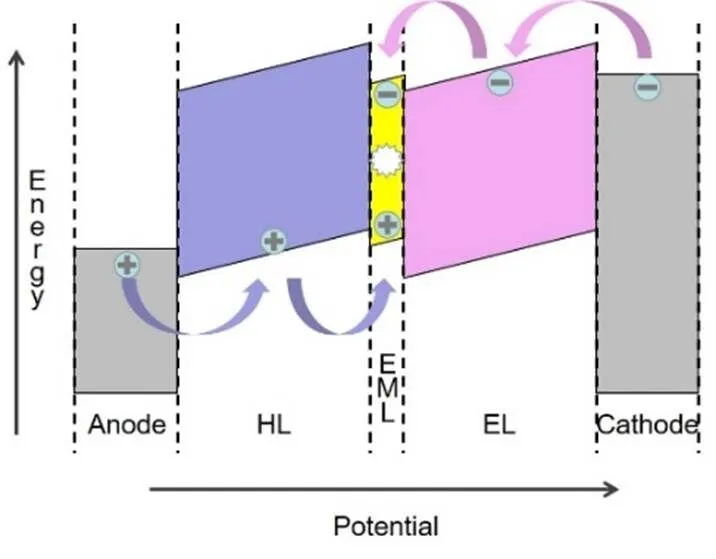
图2 OLEDs结构及发光原理示意图[19]
1.2 OLED白光器件结构发展
从产业化发展方向来看,OLED白光器件可以分为最初的单层发光白光器件、多层发光白光器件和目前主流的叠层白光器件,如图3所示。单层发光白光器件(图3(a))指的是将混合互补色掺杂材料共蒸镀在同一个发光层中,利用能量转移使得器件呈现混合后的白色,但因为很难实现完全转移,导致器件整体效率不高[20]。多层发光白光器件(图3(b))指的是将不同颜色的掺杂材料掺入不同发光层中,通过不同颜色的发光层来实现整体器件的白光显示。由于膜层增加,多层发光白光器件的工作电压更高,且相邻的发光层必将导致激子的集中分布,导致其光的稳定性及寿命均不佳[21]。
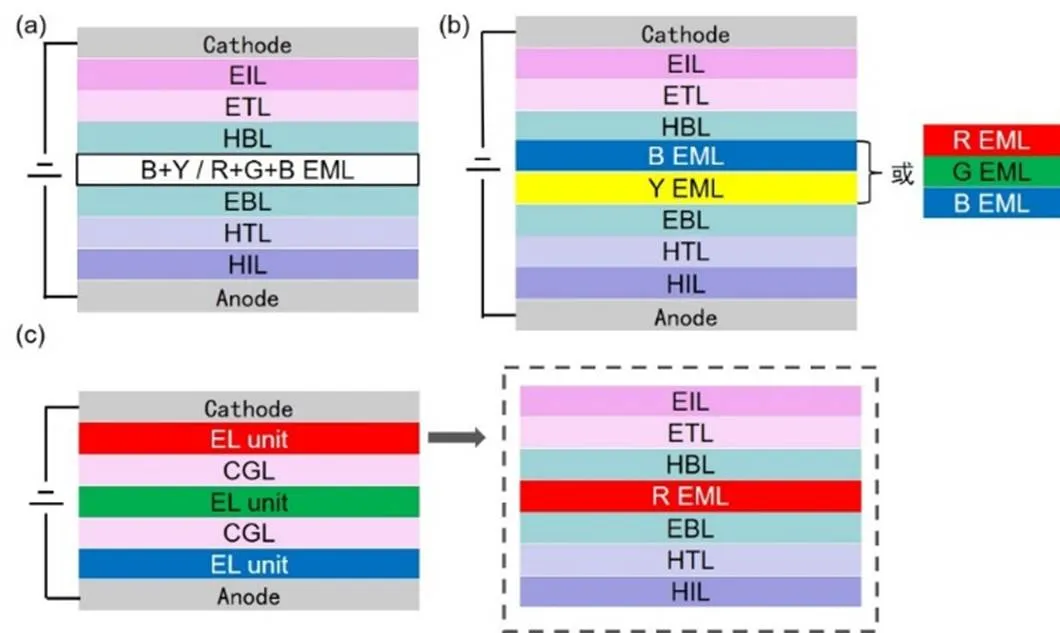
图3 OLED电致发光结构示意图(a)单层白光OLED器件,(b)多层白光OLED器件,(c)叠层白光OLED器件
叠层串联白光器件结构(图3(c))最早是由日本大学的Kido教授[22]所提出的,指将多个颜色相同或不同的发光单元(Emitting Layer unit,EL unit)用CGL垂直连接,形成白光显示的一类器件。由于串联式结构该类器件工作电流低,因此相较于单层及多层结构具备一定的寿命优势,同时在同一电流密度下串联式结构具备较高电流效率及亮度。但由于叠层白光器件中各个颜色独立发光,器件膜层厚度较厚,因此其工作电压及色彩稳定性等方面仍存在一定的问题[23-24]。同时,受限于有机材料本身的理化性质,叠层白光器件也存在寿命及效率难以提升的难关。近年研究者对高效叠层OLED白光器件进行多维度的深入探讨,以下将针对光电效率、寿命及工作电压等多方面对叠层OLED白光器件的CGL和发光单元发展进行论述。
1.3 CGL材料、结构及性能检测方法
近年的研发工作让研究者们发现CGL功能层的优化是一条获取高效率的白光OLED器件的技术路径。自2003年报道的第一种采用n型掺杂有机材料/透明导电材料的CGL起[25],研究者纷纷证明CGL在高效率叠层OLED白光器件中的起着至关重要的作用[26-27]。
CGL在电场的作用下通过n/p半导体层结合界面的异质结[28-31]拥有产生及分离载流子——电子/空穴的能力,并将产生的电子/空穴分别注入到附近的发光单元使其发光[32]。因此,CGL可以将一对由电极注入的电子/空穴转换为多个激子,从而能激发出更多的光子,使得叠层OLED器件在较低电流密度下可以获得更高的亮度和电流效率。同时较低的电流密度大大减小器件中电流的泄漏以及OLED被击穿的风险,有利于延长OLED器件的使用寿命[33-36]。此外,高效的CGL需要包含良好的电荷产生/分离性能(高电荷迁移率或电导率[37-39])、较小的注入势垒[40-41]、较小的消光系数、良好的导电性和长时间工作稳定性[42]等理化性质。
CGL通常由表1所示的p-n结组成,中间连接器的p型半导体层通常由金属氧化物构成,包括氧化铟锡(ITO)、V2O5、WO3、MoO3或掺杂Lewis酸(如FeCl3: N,N-二苯基-N,N-二[萘基-1]-4,4-联苯二胺(NPB))的有机空穴传输材料等构成;而n型半导体层则多由掺杂低功函数金属或碱金属氧化物的电子传输材料制备而成,如Cs、Li、Mg、Rb2O3等。除却常见的CGL材料结构外,还有金属材料p型半导体层,C60型p型半导体层等。
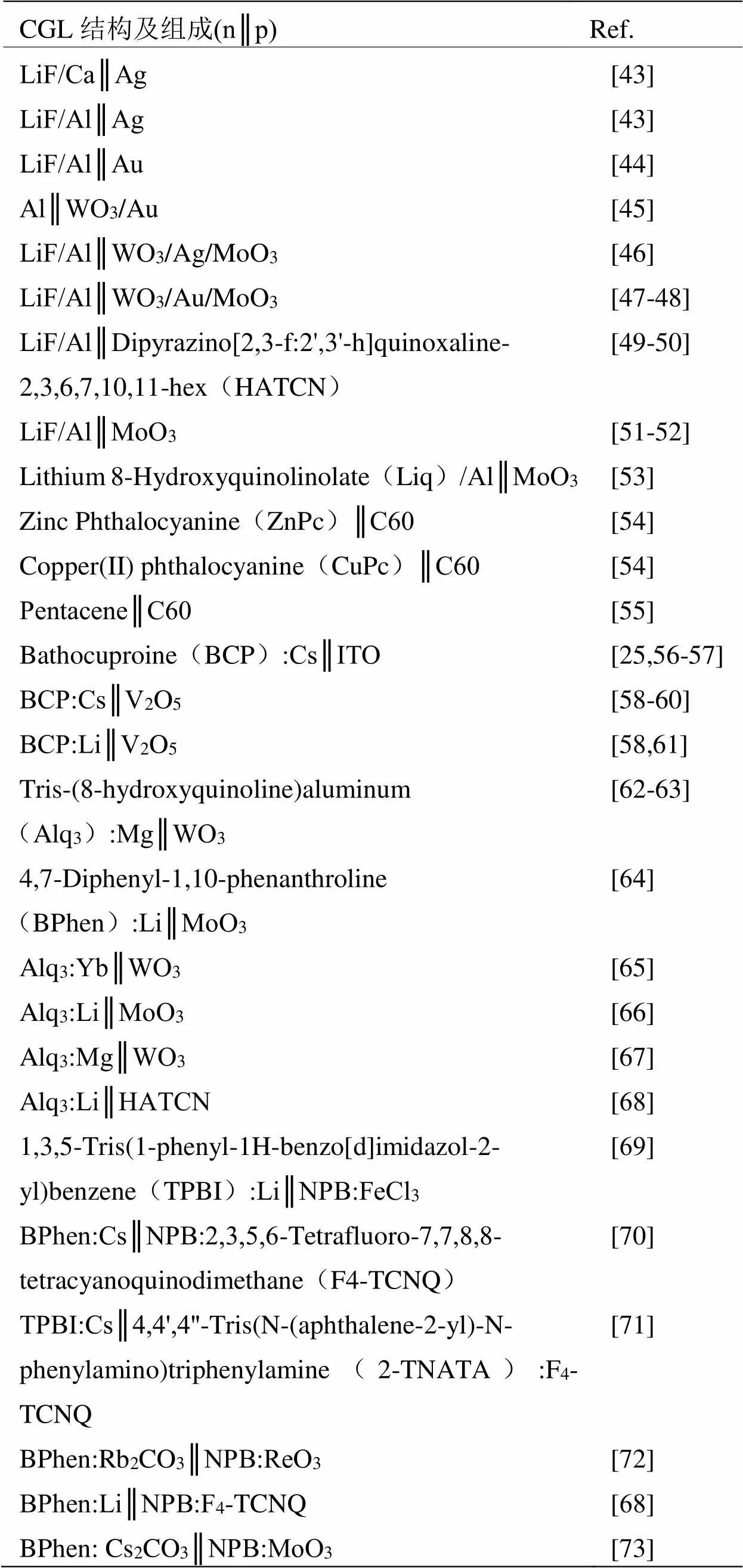
表1 常见叠层OLED器件CGL的组成
在n型半导体层中电子注入性能主要由金属功函数控制[74],电子注入势垒将随着金属掺杂剂功函数的降低而降低,从而采用低功函数的掺杂以保证器件的电学性能。Tang[75]等人分别采用Alq3:Mg,Alq3:Yb及Alq3:Ca作为CGL中n半导体层,其中Mg,Yb及Ca的功函数分别为3.6eV,2.6eV,及2.9eV。如图4(a)所示,原始Alq3膜的HOMO位于EF以下1.55eV处,其电离电势(IP)估计为5.75eV[76],可以看出,有机层中的金属掺杂导致了相当大的带弯曲,表明电荷从金属转移到Alq3分子内,并以可移动的Alq3-的形式储存,同时从n半导体层到Alq3层的电子注入势垒与3种不同金属掺杂剂的功函数变化一致。对于叠层OLED白光器件而言,垂直电导率高则有利于获得较低的驱动电压,Tang等人认为反应性金属掺杂使得金属和Alq3分子之间发生化学键合导致产生新的复合物,采用不同的金属掺杂材料可以获得了不同电导率的n半导体层,同时主体材料采用电导率更高的BPhen也可获得更低的驱动电压。值得注意的是,例如Li等金属掺杂在有机层中具有较高的扩散率,在Alq3及BCP中甚至可达到80nm[77],该特性是不利于制备长寿命器件的。
CGL的材料、组成、折射率/消光系数(/值)及与相邻功能层的匹配等从微观方面影响着器件的性能,然而叠层OLED白光器件整体的光电性能的优良难以判别CGL的优化方向。阻抗谱是一种广泛用于无机半导体和固液界面研究的工具[78],可用于研究本体或界面区域中结合或移动电荷的动力学,具有无损分析的巨大优势。Chen等[79]人采用电容电压(-)测量来验证CGL的性能,该方法通过将如图4(b)所示的CGL器件等效为RC电路,对其施加额外的AC信号,并通过其监测电容值的变化获得载流子行为信息。图4(b)中CGL两端为与阳极接触的电子传输层(Bphen)和与阴极接触的空穴传输层(NPB),该结构可观察由CGL产生的电子和空穴注入传输层的性能并且阻挡从电极注入的载流子对研究结果的影响。图4(c)中曲线可分为4个区域,I区中电场不足以弯曲CGL能带,载流子不能隧穿能垒,此时电容值为器件本征电容。II区中电场足以使得电荷产生分离,但不足以克服传输层界面(NPB和Bphen)处的能垒从而在界面上积累载流子,导致电容值上升。III及IV区中电场使得电极上的载流子进入传输层内并与界面上的载流子互相消耗导致电容值下升。该过程中曲线的拐点电压代表CGL工作电压,电容峰值代表分离的电荷数量,斜率代表电荷分离效率,从而对-曲线分析可获得CGL结构精细优化方向。
不同结构的CGL在光学性能或产业化方面仍然存在一定的缺陷:如采用金属材质p/n型半导体层的CGL具有一定的光反射性,可见光的透过率较低,影响器件的出光效率;而采用低功函数碱金属n型半导体层的CGL则由于容易氧化,在空气中状态极不稳定,对使用以及保存条件要求较高;而若采用碱金属氧化物n型半导体层的CGL虽然理化性质相对稳定[80-81],但材料蒸发温度较高,同样给实际应用带来一定的困难。因此对高效CGL的工作机理、结构创新以及制备方法更新换代仍需着重研究,从而有效指导叠层OLED白光器件产业化发展的方向。
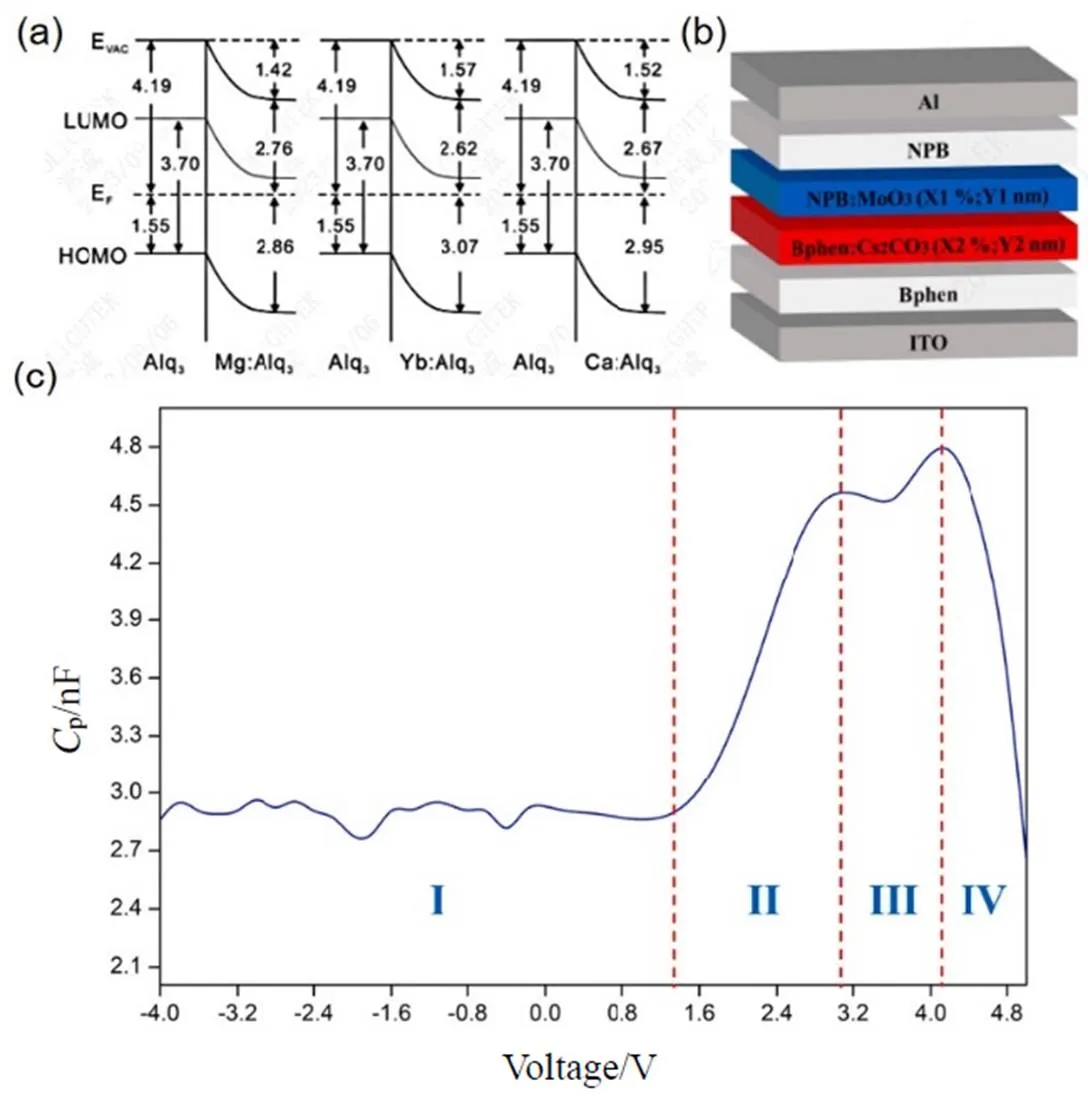
图4 CGL能级性质及CGL性能检测方法(a)分别为Alq3/Mg:Alq3、Alq3/Yb:Alq3和Alq3-Ca:Alq3界面的能级图[75],(b) CGL器件示意图,(c) CGL器件的C-V分析 (@100Hz)[79]
1.4 EML材料及结构
采用高性能的CGL是获得高效叠层OLED白光器件的一个必要条件,但同时高效的EL单元也是不可或缺的。而高效的EL单元主要由OLED白光器件结构及EML材料性质两部分决定:为确保叠层OLED白光器件的每层EML都能产生高效的可见光发射,在关注由器件结构引申出的电荷注入效率、电荷输运、电荷平衡、激子产生、激子扩散、激子猝灭、波导/表面等离子体/衬底模式、微腔效应等问题[82-90]的同时,对于EML材料选择也至关重要。下面将重点介绍荧光、磷光、TADF和混合发光材料叠层OLED白光器件中的应用及其结构优化。
1.4.1 荧光发光材料叠层OLED白光器件
荧光材料具备稳定性好,器件寿命较长的优势,但由于荧光材料只能通过单重态激子能辐射跃迁发出电致荧光,因此依据自旋统计规律内量子效率上限只能达到25%,其余的能量则因三重激发态激子的非辐射跃迁转化为振动能而损失。
首个荧光发光材料策略的叠层OLED白光器件采用Alq3:4-(二氰基亚甲基)-2-叔丁基-6-(1,1,7,7-四甲基久罗尼定基-4-乙烯基)-4H-吡喃(DCJTB)作为红色,Alq3作为绿色和9,10-2(2-萘基)蒽(AND)作为蓝色荧光EML[61];并通过BCP:Li║V2O5作为CGL层对发光单元进行连接。此白光器件在不同工作电压下的光谱曲线无较大变化(图5(a)),且具备较高的电流效率(10.7cd×A-1@3.5mA cm-2)及较高的亮度(10200cd m−2),自此后研究者们在荧光叠层OLED白光器件方面进行广泛的研究[91]。Ho等人[92]使用Bphen:Cs2CO3║NPB: WO3作为CGL层连接两个荧光发光单元,其发光单元具体结构为Bphen+蓝色荧光2-甲基-9,10-二[萘-2-基]蒽(MADN):NPB:1-4-二[4-(N,N-二苯基)氨基]苯乙烯基苯(DSA-Ph)+黄色荧光MADN:NPB:DSA-Ph:Rb+四丙基氯化铵(TPAC)。在此策略下的荧光叠层OLED白光器件电流效率高达23.9cd×A-1(@20mA×cm-2)接近理论值(图5(b))。尽管荧光叠层OLED白光器件的亮度和效率可以随发光单元的数量线性扩展,但受限于三重激发态激子的非辐射衰减,导致这类器件的性能难以满足工业化需求[93]。
1.4.2 磷光发光材料叠层OLED白光器件
与荧光材料不同,磷光材料理论上可以利用100%的激子能[21,94]。随着材料的发展,单层磷光EML器件的外量子效率可以达到20%以上[95-96]。磷光材料作为发光材料是目前OLED器件发光材料的主流开发方向,将其应用于叠层OLED白光器件中可进一步提升器件性能。
Kanno等[64]首先提出采用磷光发光材料的叠层OLED白光器件,其采用Bphen:Li║MoO3作为CGL并将两个白色磷光发光单元连接。图6(a)显示此器件的材料及能级结构,如图所示每个发光单元均为红绿光+蓝绿光发光层:其红绿光采用混合掺杂结构,将三[2-苯基吡啶]合铱(Ir(ppy)3)及乙酰乙酸二[2-苯基喹啉]铱(PQIr)分别作为绿色及红色荧光掺杂材料加入4,4-二[9-咔唑]联苯(CBP)主体材料中。此器件在亮度为500cd×m-2时,达到51.0±3.2%的外量子效率。王等人[97]首先通过研究高效的单层有机磷光发光白光器件,其峰值功率效率为42.5lm×W-1及19.3%的外量子效率。此器件是将用于蓝色荧光掺杂Ir(III)[二[4,6二氟苯基]-吡啶-N,C2]吡啶甲酸(FIrpic)和用于橙色荧光掺杂二[2-(9,9-二乙基-9h-芴-2-基)-1-苯基-1H-苯并咪唑-N,C3]Ir(乙酰丙酮)((fbi)2Ir(acac))共同掺杂到单能量阱状发射层9,9-(1,3-苯基)二-9H-咔唑(mCP)中,此结构的高效主要来源于两个平行通道的共存,即空穴捕获后直接形成激子并将电子直接注入到(fbi)2Ir(acac)分子上,以及从主体mCP到FIrpic分子的有效能量转移以获取激子。随后该团队采用BCP:Li║MoO3的CGL对两个高效共掺杂白光发光层进行串联如图6(b),最终该叠层器件的最大电流效率为110.9cd×A-1,外量子效率为43.3%[98]。随着材料的开发,研究者提出更多具有高外量子效率的磷光材料。Lee等[99]采用水平定向发射偶极子的红-绿磷光材料共掺杂形成具备32%外量子效率的橙色磷光OLED器件,并通过BPhen:Rb2CO3║HATCN/TAPC(4-(1-(4-(二[4-甲基苯基]氨基)苯基)环己基)-N-(3-甲基苯基)-N-(4-甲基苯基)苯胺)结构的CGL将橙色及蓝色发光单元进行连接(如图7(a)所示)。基于经典偶极子模型进行模拟,优化EML在叠层磷光OLED白光器件中的位置以及有机层和ITO层的总厚度(如图7(b)所示),外量子效率达到52.6%(@1000cd×m-2。

图5 磷光叠层OLED白光器件的光电性能(a)首个磷光叠层OLED白光器件的发光光谱随电压变化的趋势[61],(b) 器件1和器件2的电流效率/外量子效率与电流密度之间的关系[92]
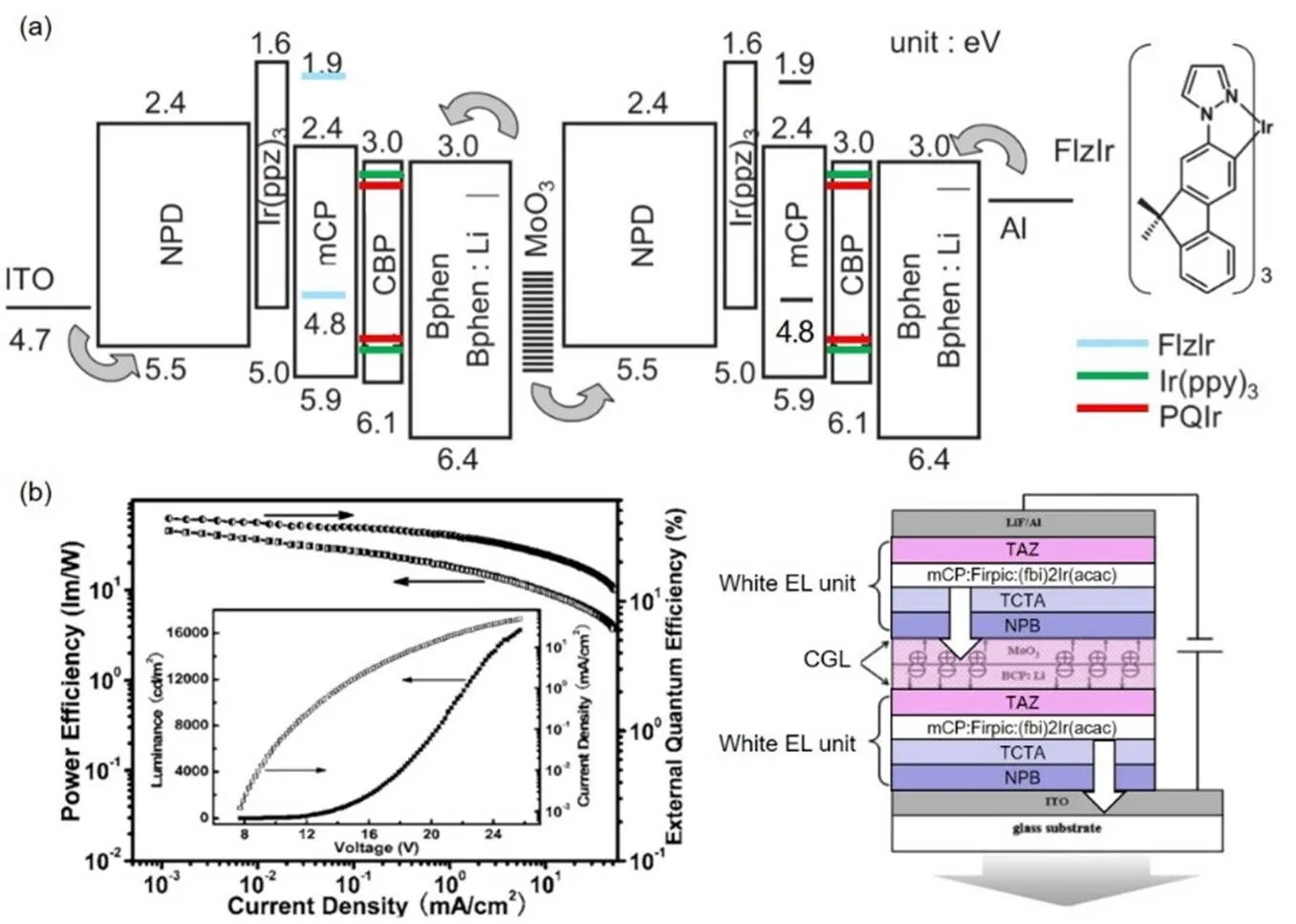
图6 磷光叠层OLED白光器件的能级、结构及光电性能(a) 采用Ir(ppy)3及PQIr共掺杂CBP主体材料红绿光以及FlzIr掺杂mCP主体材料蓝绿光的器件材料及能级结构示意图(插图:FlzIr结构式)[64];(b) 采用蓝色磷光掺杂材料FIrpic以及橙色磷光掺杂材料(fbi)2Ir(acac)共掺杂mCP主体材料中的高效叠层有机磷光发光白光器件的功率效率、外量子效率(插图:电压-亮度及电压-电流密度图)[97]以及结构示意图[98]
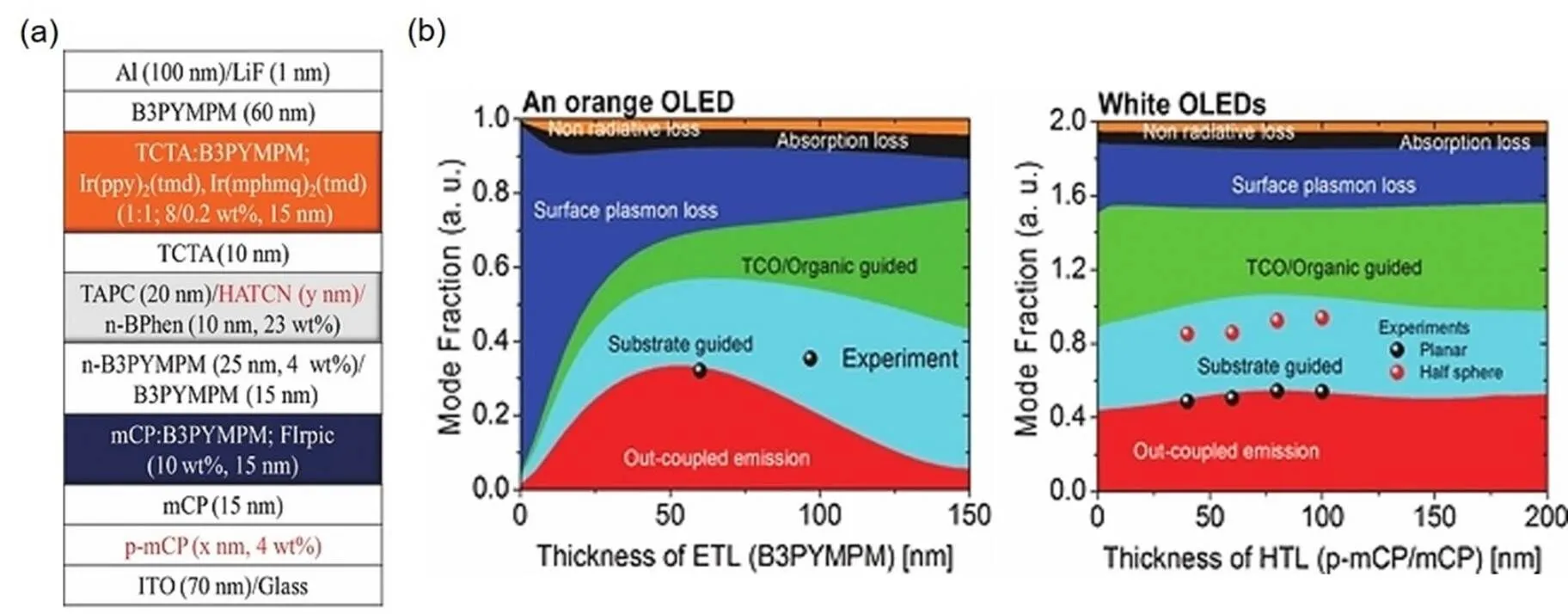
图7 采用TCTA:三[4-咔唑-9-基苯基]胺(TCTA):4,6-双(3,5-二(3-吡啶)基苯基)-2-甲基嘧啶(B3PYMPM:Ir(ppy)2(tmd)):二[2-苯喹啉]四甲基庚二酸铱(Ir(mphmq)2(tmd))的橙色磷光EML以及mCP:B3PYMPM:FIrpic的蓝色磷光EML的叠层磷光OLED白光器件结构及优化(a)功能层结构;(b) 基于经典偶极子模型对橙色磷光OLED器件以及叠层磷光OLED白光器件进行模拟优化[99]
目前蓝光磷光材料的寿命及稳定性较差[100-102],而其寿命对于防止颜色变化和亮度随着老化而迅速下降至关重要。目前仍未有可以作为工业生产的蓝色磷光材料,而近期Coburn等研究者为获得长寿命的蓝色磷光发光单元采用浓度分级掺杂和热激发态管理来增加蓝光磷光材料的稳定性[103]。浓度分级掺杂可以平衡EML中的空穴和电子传递,拓宽激子复合区,降低导致分子解离的双分子淬灭率[104]。此外,他们采用的深蓝色发光材料Mer-三-(n-苯基,n-甲基吡啶咪唑-2-基)铱(III)(Mer-Ir(pmp)3)通常被用于通过降低由于热激发态所导致的EML主体或EML掺杂材料分子降解的概率来提高蓝色元素的可靠性[105]。
结构的优化仍然不能彻底解决蓝色磷光材料发光效率较低,寿命短等性能问题,获取稳定高效的蓝色磷光材料或许是磷光叠层OLED白光器件主要发展方向。
1.4.3 TADF发光材料叠层OLED白光器件
热活化延迟荧光材料是继荧光材料、磷光材料之后的第三代材料,它可以通过由于热活化导致的反向系间穿越(Reverse Inter System Crossing,RISC)综合利用单重态和三重态激子[106-107](热活化机理的实现需三重态T1与单重态S1之间的能隙≤0.2eV[108-109]),TADF发射器可达到100%的理论内量子效率[110]。从2012年日本九州大学发表关于热活化延迟荧光材料研究[13,111]到目前国内相关课题组[112]都在进行该类材料的研究,热活化延迟荧光材料成为目前OLED材料研究的热点方向。
Zhao等[113]采用TCTA:Bphen作为蓝色TADF EML[114],1,1-二(二-4-甲苯氨基)苯基)环己烷(TAPC)和2,4,6-三(3-(1H-吡唑-1-基)苯基)-1,3,5-三嗪(3P-T2T)作为橙色TADF EML(图8(a))。通过时间分辨光致发光光谱(图8(b)),研究者通过蓝色和橙色激发的延迟时间,证明橙色和蓝色EML均基于TADF机制发光[115]。研究者基于两个EML,并采用3P-T2T:Cs2CO3|Al║MoO3作为CGL,设计出TADF发光材料叠层OLED白光器件。该器件能获得5451cd×m-2的亮度,最大电流效率为25.4cd×A-1,最大外量子效率为9.17%。值得注意的是,该结构载流子注入及运输平衡且电子与空穴有效复合使得不同电压下CIE色坐标变化小。
目前TADF发光材料叠层OLED白光器件的发光效率仍然较低,特别在蓝色TADF EML中该缺陷更为凸出[113]。
1.4.4 混合发光材料叠层OLED白光器件
全磷光器件由于强自旋轨道耦合可以捕获所有的重态激子及三重态激子,被认为是获得高效白光的最有前途的策略,然而蓝色磷光材料在寿命及色彩纯度方面限制了磷光叠层OLED白光器件的发展。因此,蓝色荧光材料结合红、绿磷光材料或黄色磷光材料的混合结构是目前实现OLED白光显示或照明产业的主要途径之一。
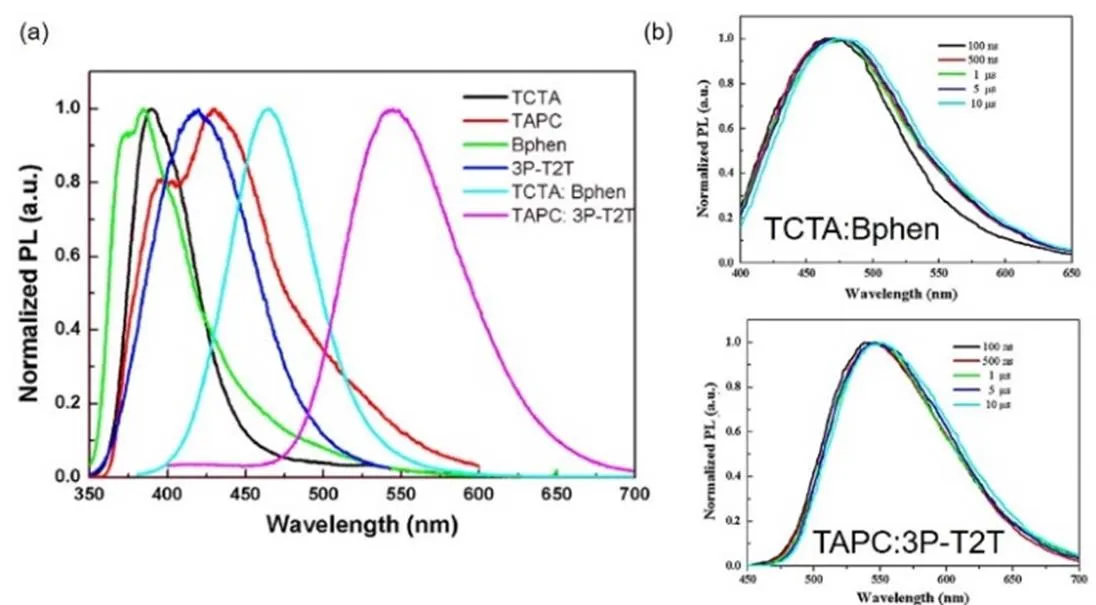
图8 TCTA:Bphen作为蓝色TADF EML以及TAPC:3P-T2T作为橙色TADF EML的光学分析(a)归一化发射光谱以及(b)在300 K下不同延迟时间下的归一化时间分辨光致发光光谱[113]
针对磷光及荧光材料混合的体系,Shi等采用LiF║HATCN(LiF/Ca(Al)║HATCN)作为CGL连接蓝色荧光EML和橙色磷光EML的形成荧光-磷光混合叠层OLED白光器件(图9)[116]。他们认为Ca可以降低p-n结之间的势垒,因此采用Ca金属薄层的CGL具备更低的电压(5.9V@100cd×m-2)。在此CGL的基础上研究者通过制备绿色和红色磷光EML与蓝色荧光EML组成的混合叠层OLED白光器件,获得26.8%的外量子效率。
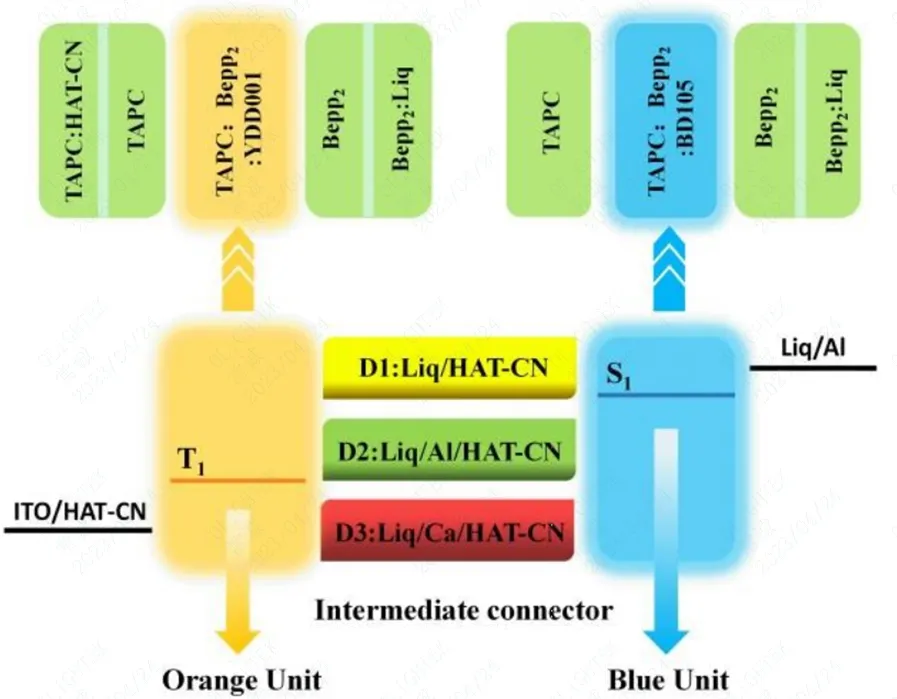
图9 具有三种不同CGL的荧光-磷光混合叠层OLED白光结构[116]
然而,由于传统荧光染料只能捕获单重态激子的性质,这种荧光-磷光混合结构的设计只能有限地捕获辐射衰变的激子,增加设计高效混合发光材料叠层OLED白光器件的难度[117-118],因此采用蓝光TADF材料配合红、绿或者橙光磷光材料组合形成白光,可以实现更高效的混合发光材料叠层OLED白光器件。
Zhang等基于蓝色TADF材料研发出第一款混合发光材料叠层OLED白光器件,该器件最大外量子效率为22.5%,最大功率效率为47.6lm×W-1[119]。Wu等人[120]开发出一种三色混合器件,其采用高效的蓝色TADF发射器与红色和绿色磷光发射器相结合,在利用蓝-绿-红级联能量转移结构时,实现51.7lm×W-1的最大前视功率效率及89显色指数(CRI)的白光器件。Huang等人[121]报道的基于TADF的混合发光材料叠层OLED白光器件,其最大电流效率和EQE分别为78.5cd×A-1和28.5%。
研究者对此类高效率器件的材料进行大量的研究,但很少有人优化器件结构设计来最大限度地利用三重态激子。Huang等人在之前的研究基础上开发一种新的混合四色混合发光材料叠层OLED白光器件设计[122],其结构如图10(a),该设计由基于激基复合物主体的黄红色发射单元(Yellow-Red Unit,YRU)和包含TADF蓝色发射器的蓝红色发射单元(Blue-Red Unit,BRU)构成。在该策略中,TADF机制被充分利用(图10(b)),具有分子间相互作用诱导的TADF特性的激基复合物被用作主体材料使得器件驱动电压较低。值得注意的是,控制BRU中的磷光红色掺杂剂浓度形成两个辐射通道,使得过量的蓝色激子可以转移到红色发射极,这可以稳定蓝色发射极,尤其是在高亮度下的稳定性极佳。采用该结构的器件最大EQE和功率效率分别为42.9%和66.3lm×W-1。
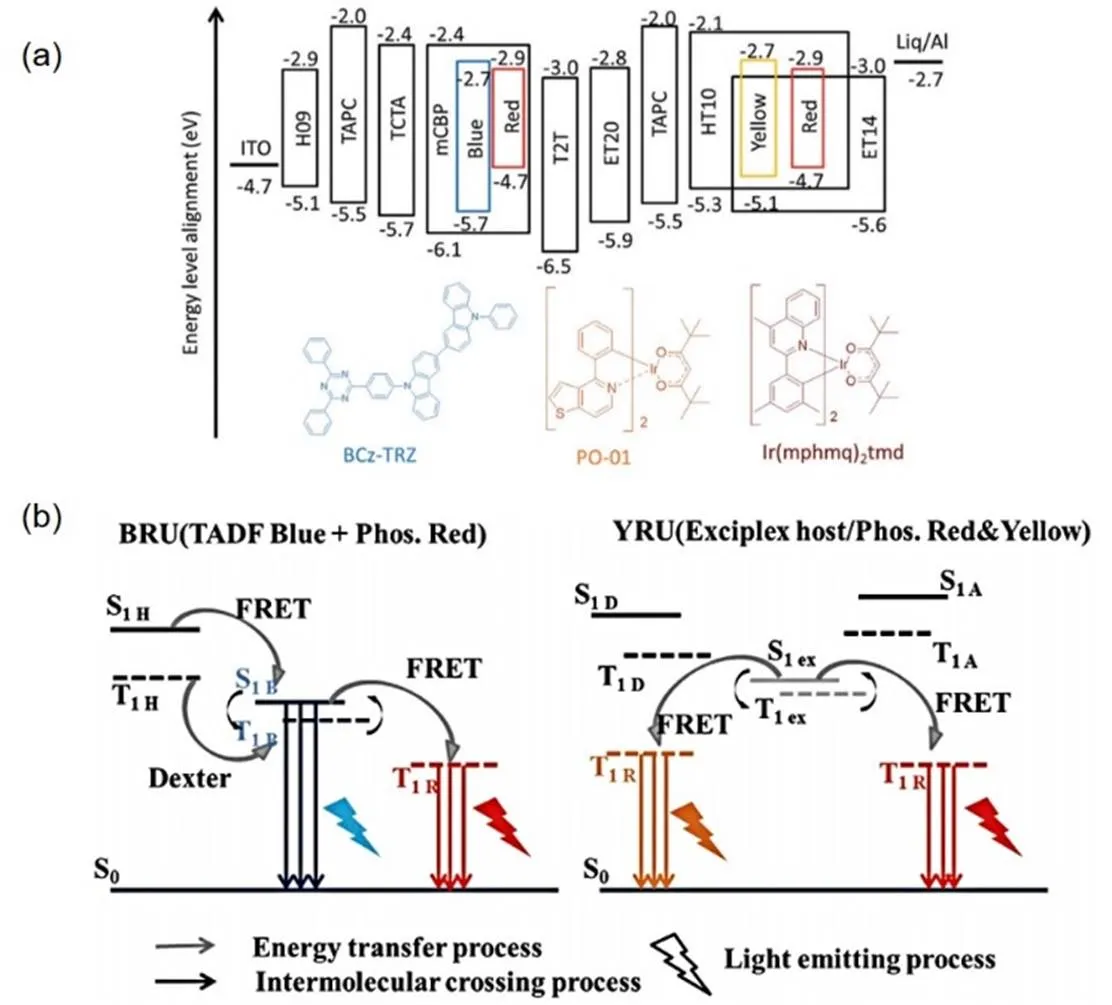
图10 BRU+YRU混合叠层OLED白光器件能级结构及工作机理(a) 能级结构示意图,以及蓝色TADF和黄色和红色磷光掺杂料的化学结构,(b)工作机制[122]
2 总结及展望
叠层OLED白光器件的性能一直处于不断改进中,如今可以满足手机、灯具和电视的实际商业化需求。本文针对工程化应用需求,总结近年来对高效叠层OLED白光器件的研究进展,重点关注CGL结构以及有机发光单元结构。
到目前为止,效率、驱动电压、稳定性等方面仍然制约叠层OLED白光器件进一步的商业化应用。第一,叠层OLED白光器件的理论效率极限约为248lm×W-1,目前采用混合发光材料叠层OLED白光器件方案仅能使效率达到66.3lm×W-1,仍有很大的提升空间。第二,叠层OLED白光器件的驱动电压较高,这不仅增加器件的功耗,并且不利于进一步提升功率效率。第三,叠层OLED白光器件由于采用不同发光层进行串联,因此每个发光层的起亮电压均不相同,这对器件在低亮度情况下的色彩稳定性提出重大挑战;同时由于相邻透明层之间的折射率具有一定差异,器件会受到微腔效应的影响,因此显示颜色在所有角度上的稳定性也是一个严重的问题。本文针对叠层OLED白光器件,从EML对激子进行有效的光电转换,CGL高效的电荷产生及分离性能,功能层电荷和激子分布精细化管理3个方面进行论述总结,并提出了C-V法优化CGL电学性能、发光层并行通道激子收集、四色混合磷光TADF材料等多类优化方法。
[1] LIU B, XU M, TAO H, et al. Highly efficient red phosphorescent organic light-emitting diodes based on solution processed emissive layer[J]., 2013, 142: 35-39.
[2] XIANG C, KOO W, SO F, et al. A systematic study on efficiency enhancements in phosphorescent green, red and blue microcavity organic light emitting devices[J]., 2013, 2(6): e74-e74.
[3] Burroughes J H, Bradley D D C, Brown A R, et al. Light-emitting diodes based on conjugated polymers[J]., 1990, 347(6293): 539-541.
[4] YANG X, ZHOU G, WONG W Y. Functionalization of phosphorescent emitters and their host materials by main-group elements for phosphorescent organic light-emitting devices[J]., 2015, 44(23): 8484-8575.
[5] Jou J H, Kumar S, Agrawal A, et al. Approaches for fabricating high efficiency organic light emitting diodes[J]., 2015, 3(13): 2974-3002.
[6] FAN C, YANG C. Yellow/orange emissive heavy-metal complexes as phosphors in monochromatic and white organic light-emitting devices[J]., 2014, 43(17): 6439-6469.
[7] XIAO P, HUANG J, YU Y, et al. Recent developments in tandem white organic light-emitting diodes[J]., 2019, 24(1): 151.
[8] Bernanose A, Comte M, Vouaux P. A new method of emission of light by certain organic compounds[J]., 1953, 50: 64-68.
[9] Pope M, Kallmann H P, Magnante P. Electroluminescence in organic crystals[J]., 1963, 38(8): 2042-2043.
[10] TANG C W, VanSlyke S A. Organic electroluminescent diodes[J]., 1987, 51(12): 913-915.
[11] Madhava Rao M V, Kuin Su Y, HUANG T S, et al. White organic light emitting devices based on multiple emissive nanolayers[J]., 2010, 2: 242-246.
[12] Eslamian M. Inorganic and organic solution-processed thin film devices[J]., 2017, 9(1): 3.
[13] Uoyama H, Goushi K, Shizu K, et al. Highly efficient organic light-emitting diodes from delayed fluorescence[J]., 2012, 492(7428): 234-238.
[14] LIU B, LI X L, TAO H, et al. Manipulation of exciton distribution for high-performance fluorescent/phosphorescent hybrid white organic light-emitting diodes[J]., 2017, 5(31): 7668-7683.
[15] Tyan Y S. Organic light-emitting-diode lighting overview[J]., 2011, 1(1): 011009-011009.
[16] LIU B Q, GAO D Y, WANG J B, et al. Progress of white organic light-emitting diodes[J]., 2015, 31(10): 1823-1852.
[17] 陈金鑫, 黄孝文. OLED有机电致发光材料与器件[M]. 北京: 清华大学出版社, 2007.
CHEN J X, HUANG X W.[M]. Beijing: Tsinghua University Press, 2007.
[18] 应根裕, 胡文波, 邱勇. 平板显示技术[M]. 北京: 人民邮电出版社, 2002.
YING G Y, HU W B, QIU Y.[M]. Beijing: People's Posts and Telecommunications Publishing House, 2002.
[19] 付相杰. 电荷产生层厚度对叠层式白光OLED性能影响的研究[D]. 上海: 上海交通大学, 2015.
FU X J. Study of the Effect of Charge-Generating Layer Thickness on the Performance of Stacked White OLEDs[D]. Shanghai: Shanghai Jiao Tong University, 2015.
[20] KO Y W, CHUNG C H, LEE J H, et al. Efficient white organic light emission by single emitting layer[J]., 2003, 426(1-2): 246-249.
[21] Reineke S, Lindner F, Schwartz G, et al. White organic light-emitting diodes with fluorescent tube efficiency[J]., 2009, 459(7244): 234-238.
[22] Kido J. High performance OLEDs for displays and general lighting[J]., 2008, 39(1): 931-932.
[23] Burrows P E, Khalfin V, GU G, et al. Control of microcavity effects in full color stacked organic light emitting devices[J]., 1998, 73(4): 435-437.
[24] Nowatari H, Ushikubo T, Ohsawa N, et al. Intermediate connector with suppressed voltage loss for white tandem OLEDS[C]//, 2009, 40(1): 899-902.
[25] Kido J, Matsumoto T, Nakada T, et al. High efficiency organic el devices having charge generation layers[C]//, 2003, 34(1): 964-965.
[26] PU Y J, Chiba T, Ideta K, et al. Fabrication of organic light-emitting devices comprising stacked light-emitting units by solution-based processes[J]., 2015, 27(8): 1327-1332.
[27] YU J, YIN Y, LIU W, et al. Effect of the greenish-yellow emission on the color rendering index of white organic light-emitting devices[J]., 2014, 15(11): 2817-2821.
[28] LI X L, OUYANG X, LIU M, et al. Highly efficient single-and multi-emission-layer fluorescent/phosphorescent hybrid white organic light-emitting diodes with 20% external quantum efficiency[J]., 2015, 3(35): 9233-9239.
[29] Kim D Y, Park J H, Lee J W, et al. Overcoming the fundamental light-extraction efficiency limitations of deep ultraviolet light-emitting diodes by utilizing transverse-magnetic-dominant emission[J]., 2015, 4(4): e263-e263.
[30] XIAO P, HUANG J, DONG T, et al. Room-temperature fabricated thin-film transistors based on compounds with lanthanum and main family element boron[J]., 2018, 23(6): 1373.
[31] LIU B, XU Z, ZOU J, et al. High-performance hybrid white organic light-emitting diodes employing p-type interlayers[J]., 2015, 27: 240-244.
[32] CHEN Y, MA D. Organic semiconductor heterojunctions as charge generation layers and their application in tandem organic light-emitting diodes for high power efficiency[J]., 2012, 22(36): 18718-18734.
[33] Hwang S H. Stable blue thermally activated delayed fluorescent organic light-emitting diodes with three times longer lifetime than phosphorescent organic light-emitting diodes[J]., 2015, 27(15): 2515-2520.
[34] SHI Z, LI Y, LI S, et al. Localized surface plasmon enhanced all-inorganic perovskite quantum dot light-emitting diodes based on coaxial core/shell heterojunction architecture[J]., 2018, 28(20): 1707031.
[35] XIAO P, HUANG J, YU Y, et al. Recent advances of exciplex-based white organic light-emitting diodes[J]., 2018, 8(9): 1449.
[36] LIU B, XU M, WANG L, et al. Investigation and optimization of each organic layer: a simple but effective approach towards achieving high-efficiency hybrid white organic light-emitting diodes[J]., 2014, 15(4): 926-936.
[37] LIU B, XU M, WANG L, et al. Comprehensive study on the electron transport layer in blue flourescent organic light-emitting diodes[J]., 2013, 2(11): R258-R261.
[38] LIU B, XU M, WANG L, et al. Simplified hybrid white organic light-emitting diodes with efficiency/efficiency roll-off/color rendering index/color-stability trade-off[J].(), 2014, 8(8): 719-723.
[39] DU X, TAO S, HUANG Y, et al. Efficient fluorescence/phosphorescence white organic light-emitting diodes with ultra high color stability and mild efficiency roll-off[J]., 2015, 107(18): 183304.
[40] CHEN Y H, MA D G, SUN H D, et al. Organic semiconductor heterojunctions: electrode-independent charge injectors for high-performance organic light-emitting diodes[J]., 2016, 5(3): e16042-e16042.
[41] JIANG C, LIU H, LIU B, et al. Improved performance of inverted quantum dots light emitting devices by introducing double hole transport layers[J]., 2016, 31: 82-89.
[42] SUN H, CHEN Y, CHEN J, et al. Interconnectors in tandem organic light emitting diodes and their influence on device performance[J]., 2015, 22(1): 154-163.
[43] SUN J X, ZHU X L, PENG H J, et al. Effective intermediate layers for highly efficient stacked organic light-emitting devices[J]., 2005, 87(9): 093504.
[44] ZHAO D W, SUN X W, JIANG C Y, et al. Efficient tandem organic solar cells with an Al/MoO3intermediate layer[J]., 2008, 93(8): 313.
[45] ZHANG H, DAI Y, MA D, et al. High efficiency tandem organic light-emitting devices with Al∕WO3∕Au interconnecting layer[J]., 2007, 91(12): 123504.
[46] ZHANG H M, Choy W C H, DAI Y F. Independently controllable stacked OLEDs with high efficiency by using semitransparent Al/WO3/Ag intermediate connecting layer[J].:Applied Physics, 2008, 41(10): 105108.
[47] ZHANG H M, Choy W C H. Real-time color-tunable electroluminescence from stacked organic LEDs using independently addressable middle electrode[J]., 2008, 20(13): 1154-1156.
[48] ZHANG H M, Choy W C H, DAI Y F, et al. The structural composite effect of Au–WO3–Al interconnecting electrode on performance of each unit in stacked OLEDs[J]., 2009, 10(3): 402-407.
[49] Knauer K A, Najafabadi E, Haske W, et al. Stacked inverted top-emitting green electrophosphorescent organic light-emitting diodes on glass and flexible glass substrates[J]., 2013, 14(10): 2418-2423.
[50] Chiba T, Pu Y J, Miyazaki R, et al. Ultra-high efficiency by multiple emission from stacked organic light-emitting devices[J]., 2011, 12(4): 710-715.
[51] JIAO B, WU Z, YANG Z, et al. Tandem organic light-emitting diodes with an effective nondoped charge-generation unit[J].(a), 2013, 210(12): 2583-2587.
[52] Meyer J, Kröger M, Hamwi S, et al. Charge generation layers comprising transition metal-oxide/organic interfaces: Electronic structure and charge generation mechanism[J]., 2010, 96(19): 193302.
[53] Sasabe H, Minamoto K, Pu Y J, et al. Ultra high-efficiency multi-photon emission blue phosphorescent OLEDs with external quantum efficiency exceeding 40%[J]., 2012, 13(11): 2615-2619.
[54] CHEN Y, CHEN J, MA D, et al. Effect of organic bulk heterojunction as charge generation layer on the performance of tandem organic light-emitting diodes[J]., 2011, 110(7): 074504.
[55] CHEN Y, CHEN J, MA D, et al. High power efficiency tandem organic light-emitting diodes based on bulk heterojunction organic bipolar charge generation layer[J]., 2011, 98(24): 43309-43309.
[56] Burrows P E, Forrest S R, Sibley S P, et al. Color-tunable organic light-emitting devices[J]., 1996, 69(20): 2959-2961.
[57] GU G, Parthasarathy G, TIAN P, et al. Transparent stacked organic light emitting devices. II. Device performance and applications to displays[J]., 1999, 86(8): 4076-4084.
[58] Matsumoto T, Nakada T, Endo J, et al. Multiphoton organic EL device having charge generation layer[J]., 2003, 34(1): 979-981.
[59] Tsutsui T, Terai M. Electric field-assisted bipolar charge spouting in organic thin-film diodes[J]., 2004, 84(3): 440-442.
[60] Terai M, Fujita K, Tsutsui T. Capacitance measurement in organic thin-film device with internal charge separation zone[J]., 2005, 44(8L): L1059-L1062.
[61] GUO F, MA D. White organic light-emitting diodes based on tandem structures[J]., 2005, 87(17): 173510-173510-3.
[62] CHANG C C, CHEN J F, HWANG S W, et al. Highly efficient white organic electroluminescent devices based on tandem architecture[J]., 2005, 87(25): 253501.
[63] CHANG C C, HWANG S W, CHEN C H, et al. High-efficiency organic electroluminescent device with multiple emitting units[J]., 2004, 43(9A): 6418-6422.
[64] Kanno H, Holmes R J, Sun Y, et al. White stacked electrophosphorescent organic light-emitting devices employing MoO3as a charge-generation layer[J]., 2006, 18(3): 339-342.
[65] CHAN M Y, LAI S L, LAU K M, et al. Influences of connecting unit architecture on the performance of tandem organic light-emitting devices[J]., 2007, 17(14): 2509-2514.
[66] LIAO L S, Slusarek W K, Hatwar T K, et al. Tandem organic light‐emitting diode using hexaazatriphenylene hexacarbonitrile in the intermediate connector[J]., 2008, 20(2): 324-329.
[67] BAO Q Y, YANG J P, TANG J X, et al. Interfacial electronic structures of WO3-based intermediate connectors in tandem organic light-emitting diodes[J]., 2010, 11(9): 1578-1583.
[68] LIAO L S, Klubek K P. Power efficiency improvement in a tandem organic light-emitting diode[J]., 2008, 92: 223311.
[69] LIAO L S, Klubek K P, Tang C W. High-efficiency tandem organic light-emitting diodes[J]., 2004, 84(2): 167-169.
[70] CHO T Y, LIN C L, WU C C. Microcavity two-unit tandem organic light-emitting devices having a high efficiency[J]., 2006, 88(11): 111106.
[71] Kröger M, Hamwi S, Meyer J, et al. Temperature-independent field-induced charge separation at doped organic/organic interfaces: Experimental modeling of electrical properties[J]., 2007, 75(23): 235321.
[72] Leem D S, Lee J H, Kim J J, et al. Highly efficient tandem p-i-n organic light-emitting diodes adopting a low temperature evaporated rhenium oxide interconnecting layer[J]., 2008, 93(10): 103304.
[73] YANG J P, BAO Q Y, XIAO Y, et al. Hybrid intermediate connector for tandem OLEDs with the combination of MoO3-based interlayer and p-type doping[J]., 2012, 13(11): 2243-2249.
[74] CHAN M Y, LAI S L, FUNG M K, et al. Efficient CsF/Yb/Ag cathodes for organic light-emitting devices[J]., 2003, 82(11): 1784-1786.
[75] TANG J X, FUNG M K, LEE C S, et al. Interface studies of intermediate connectors and their roles in tandem OLEDs[J]., 2010, 20(13): 2539-2548.
[76] TANG J X, LAU K M, LEE C S, et al. Substrate effects on the electronic properties of an organic/organic heterojunction[J]., 2006, 88(23): 232103.
[77] Parthasarathy G, Shen C, Kahn A, et al. Lithium doping of semiconducting organic charge transport materials[J]., 2001, 89(9): 4986-4992.
[78] Garrido J A, Nowy S, Haertl A, et al. The diamond/aqueous electrolyte interface: an impedance investigation[J]., 2008, 24(8): 3897-3904.
[79] CHEN Y Y, Tsai C T, HUANG W L, et al. Investigation and optimization of the charge generation layer (CGL) in tandem OLEDs using Taguchi’s orthogonal arrays and nondestructive capacitance-voltage (CV) measurements[J]., 2021, 274: 116713.
[80] LIU J, CHEN Y, QIN D, et al. Improved interconnecting structure for a tandem organic light emitting diode[J]., 2011, 26(9): 095011.
[81] Diez C, Reusch T C G, Lang E, et al. Highly stable charge generation layers using caesium phosphate as n-dopants and inserting interlayers[J]., 2012, 111(10): 103107.
[82] LIU B, XU M, WANG L, et al. Regulating charges and excitons in simplified hybrid white organic light-emitting diodes: The key role of concentration in single dopant host–guest systems[J]., 2014, 15(10): 2616-2623.
[83] LIU B, ZOU J, SU Y, et al. Hybrid white organic light emitting diodes with low efficiency roll-off, stable color and extreme brightness[J]., 2014, 151: 161-164.
[84] LUO D, XIAO Y, HAO M, et al. Doping-free white organic light-emitting diodes without blue molecular emitter: An unexplored approach to achieve high performance via exciplex emission[J]., 2017, 110(6): 061105.
[85] CHEN B, LIU B, ZENG J, et al. Efficient bipolar blue AIEgens for high-performance nondoped blue OLEDs and hybrid white OLEDs[J]., 2018, 28(40): 1803369.
[86] Chapran M, Angioni E, Findlay N J, et al. An ambipolar BODIPY derivative for a white exciplex OLED and cholesteric liquid crystal laser toward multifunctional devices[J]., 2017, 9(5): 4750-4757.
[87] LIU B, Delikanli S, Gao Y, et al. Nanocrystal light-emitting diodes based on type II nanoplatelets[J]., 2018, 47: 115-122.
[88] Cekaviciute M, Simokaitiene J, Volyniuk D, et al. Arylfluorenyl-substituted metoxytriphenylamines as deep blue exciplex forming bipolar semiconductors for white and blue organic light emitting diodes[J]., 2017, 140: 187-202.
[89] HUANG Q, Walzer K, Pfeiffer M, et al. Highly efficient top emitting organic light-emitting diodes with organic outcoupling enhancement layers[J]., 2006, 88(11): 113515.
[90] YOUN W, LEE J, XU M, et al. Corrugated sapphire substrates for organic light-emitting diode light extraction[J]., 2015, 7(17): 8974-8978.
[91] Yokoyama M, Su S H, Hou C C, et al. Highly efficient white organic light-emitting diodes with a p–i–n tandem structure[J]., 2011, 50(4S): 04DK06.
[92] Ho M H, Chen T M, Yeh P C, et al. Highly efficient p-i-n white organic light emitting devices with tandem structure[J]., 2007, 91(23): 233507.
[93] CHEN S, ZHAO X, WU Q, et al. Efficient, color-stable flexible white top-emitting organic light-emitting diodes[J]., 2013, 14(11): 3037-3045.
[94] SU S J, Gonmori E, Sasabe H, et al. Highly efficient organic blue‐and white‐light‐emitting devices having a carrier‐and exciton-confining structure for reduced efficiency roll-off[J]., 2008, 20(21): 4189-4194.
[95] ZHU L, WU Z, CHEN J, et al. Reduced efficiency roll-off in all-phosphorescent white organic light-emitting diodes with an external quantum efficiency of over 20%[J]., 2015, 3(14): 3304-3310.
[96] XU L, TANG C W, Rothberg L J. High efficiency phosphorescent white organic light-emitting diodes with an ultra-thin red and green co-doped layer and dual blue emitting layers[J]., 2016, 32: 54-58.
[97] WANG Q, DING J, MA D, et al. Harvesting excitons via two parallel channels for efficient white organic LEDs with nearly 100% internal quantum efficiency: fabrication and emission‐mechanism analysis[J]., 2009, 19(1): 84-95.
[98] WANG Q, DING J, ZHANG Z, et al. A high-performance tandem white organic light-emitting diode combining highly effective white-units and their interconnection layer[J]., 2009, 105: 076101.
[99] LEE S, SHIN H, KIM J J. High-efficiency orange and tandem white organic light-emitting diodes using phosphorescent dyes with horizontally oriented emitting dipoles[J]., 2014, 26(33): 5864-5868.
[100] XUE K, HAN G, DUAN Y, et al. Doping-free orange and white phosphorescent organic light-emitting diodes with ultra-simply structure and excellent color stability[J]., 2015, 18: 84-88.
[101] XUE K, SHENG R, DUAN Y, et al. Efficient non-doped monochrome and white phosphorescent organic light-emitting diodes based on ultrathin emissive layers[J]., 2015, 26: 451-457.
[102] Fleetham T, LI G, LI J. Phosphorescent Pt (II) and Pd (II) complexes for efficient, high-color-quality, and stable OLEDs[J]., 2017, 29(5): 1601861.
[103] Coburn C, Jeong C, Forrest S R. Reliable, all-phosphorescent stacked white organic light emitting devices with a high color rendering index[J]., 2018, 5(2): 630-635.
[104] ZHANG Y, LEE J, Forrest S R. Tenfold increase in the lifetime of blue phosphorescent organic light-emitting diodes[J]., 2014, 5(1): 5008-5015.
[105] LEE J, Jeong C, Batagoda T, et al. Hot excited state management for long-lived blue phosphorescent organic light-emitting diodes[J]., 2017, 8(1): 15566.
[106] Rajamalli P, Senthilkumar N, Gandeepan P, et al. A new molecular design based on thermally activated delayed fluorescence for highly efficient organic light emitting diodes[J]., 2016, 138(2): 628-634.
[107] YANG Z, MAO Z, XIE Z, et al. Recent advances in organic thermally activated delayed fluorescence materials[J]., 2017, 46(3): 915-1016.
[108] GUO J, LI X L, NIE H, et al. Achieving high-performance nondoped OLEDs with extremely small efficiency roll-off by combining aggregation-induced emission and thermally activated delayed fluorescence[J]., 2017, 27(13): 1606458.
[109] WU Z, WANG Q, YU L, et al. Managing excitons and charges for high-performance fluorescent white organic light-emitting diodes[J]., 2016, 8(42): 28780-28788.
[110] WANG J, CHEN J, QIAO X, et al. Simple-structured phosphorescent warm white organic light-emitting diodes with high power efficiency and low efficiency roll-off[J]., 2016, 8(16): 10093-10097.
[111] Goushi K, Yoshida K, Sato K, et al. Organic light-emitting diodes employing efficient reverse intersystem crossing for triplet-to-singlet state conversion[J]., 2012, 6(4): 253-258.
[112] ZHANG D, CAI M, ZHANG Y, et al. Sterically shielded blue thermally activated delayed fluorescence emitters with improved efficiency and stability[J]., 2016, 3(2): 145-151.
[113] ZHAO B, ZHANG T, CHU B, et al. Highly efficient tandem full exciplex orange and warm white OLEDs based on thermally activated delayed fluorescence mechanism[J]., 2015, 17: 15-21.
[114] DUAN Y, SUN F, YANG D, et al. White-light electroluminescent organic devices based on efficient energy harvesting of singlet and triplet excited states using blue-light exciplex[J]., 2014, 7(5): 052102.
[115] Park Y S, KIM K H, KIM J J. Efficient triplet harvesting by fluorescent molecules through exciplexes for high efficiency organic light-emitting diodes[J]., 2013, 102(15): 153306.
[116] SHI C, SUN N, WU Z, et al. High performance hybrid tandem white organic light-emitting diodes by using a novel intermediate connector[J]., 2018, 6(4): 767-772.
[117] DU X, ZHAO J, YUAN S, et al. High-performance fluorescent/ phosphorescent (F/P) hybrid white OLEDs consisting of a yellowish-green phosphorescent emitter[J]., 2016, 4(25): 5907-5913.
[118] CHEN Y, YANG D, QIAO X, et al. Novel strategy to improve the efficiency roll-off at high luminance and operational lifetime of hybrid white OLEDs via employing an assistant layer with triplet–triplet annihilation up-conversion characteristics[J]., 2020, 8(19): 6577-6586.
[119] ZHANG D, DUAN L, LI Y, et al. Highly efficient and color-stable hybrid warm white organic light-emitting diodes using a blue material with thermally activated delayed fluorescence[J]., 2014, 2(38): 8191-8197.
[120] WU Z, LUO J, SUN N, et al. High-performance hybrid white organic light-emitting diodes with superior efficiency/color rendering index/color stability and low efficiency roll-off based on a blue thermally activated delayed fluorescent emitter[J]., 2016, 26(19): 3306-3313.
[121] HUANG C, XIE Y, WU S, et al. Thermally activated delayed fluorescence-based tandem OLEDs with very high external quantum efficiency[J].(a), 2017, 214(10): 1700240.
[122] HUANG C, ZHANG Y, ZHOU J, et al. Hybrid tandem white OLED with long lifetime and 150lm×W−1in luminous efficacy based on TADF blue emitter stabilized with phosphorescent red emitter[J]., 2020, 8(18): 2000727.
Development of Highly Efficient Tandem White OLEDs
CHANG Cheng,QIAN Fuli,GOU Guoru,TANG Rui,WANG Tilu,GAO Sibo,ZHANG Weichenxi,HE Yangyang,LI Li,YANG Qiming,ZHANG Jie,LIU Yingqi,DUAN Yu,YANG Wenyun,WANG Guanghua
(Yunnan Olightek Opto-electronic Technology Co., Ltd., Kunming 650223, China)
Tandem white OLEDs offer low power consumption, high brightness, and a high color gamut. However, the material and electrical structures of tandem white OLEDs still need to be optimized owing to the outstanding challenges in efficiency, lifetime, and driving voltage. In this study, we focused on the latest research on tandem white OLEDs and summarized the problems in engineering preparation and non-destructive detection method of 3 types of CGLs for high-efficiency tandem white OLEDs. We focused on the latest research on the “all-phosphorescent system,” “harvesting excitons via two parallel channels,” and the “mixed-phosphorescent-TADF system” simultaneously. We summarized the device lifetime problems and discussed structural solutions such as "graded doping" and "four-color mixed-phosphorescent-TADF system." From the aspect of CGL materials and structures in different systems, we reviewed the scheme of lower driving voltage for tandem white OLEDs. Finally, we provided suggestions for improving the materials and structures of tandem white OLEDs.
tandem white OLEDs, CGL, Emitting Layer unit, functional layer structure, organic light-emitting material
TN312+.8
A
1001-8891(2023)11-1141-12
2023-05-31;
2023-09-20.
常诚(1996-),男,云南昆明人,硕士,主要从事电化学及硅基OLED面板的研究。E-mail: cc993242801@163.com。
段瑜(1981-),女,云南罗平人,硕士,研高工,主要从事高分子化学和物理以及硅基OLED面板的研究。E-mail: duanyu@oleid.com。
云南省科技厅科技计划项目(2022024H210001)。

